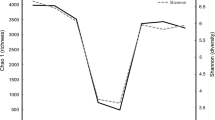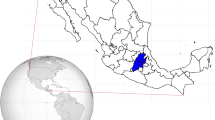Abstract
The aim of this study was to describe the microbial communities in the distal gut of wild wolves (Canis lupus). Fecal samples were collected from three healthy unrelated adult wolves captured at the nearby of Dalai Lake Nature Reserve in Inner Mongolia of China. The diversity of fecal bacteria was investigated by constructing PCR-amplified 16S rRNA gene clone libraries using the universal bacterial primers 27 F and 1493 R. A total of 307 non-chimeric near-full-length 16S rRNA gene sequences were analyzed and 65 non-redundant bacteria phylotypes (operational taxonomical units, OTUs) were identified. Seventeen OTUs (26%) showed less than 98% sequence similarity to 16S rRNA gene sequences were reported previously. Five different bacterial phyla were identified, with the majority of OTUs being classified within the phylum Firmicutes (60%), followed by Bacteroidetes (16.9%), Proteobacteria (9.2%), Fusobacteria (9.2%) and Actinobacteria (4.6%). The majority of clones fell within the order Clostridiales (53.8% of OTUs). It was predominantly affiliated with five families: Lachnospiraceae was the most diverse bacterial family in this order, followed by Ruminococcaceae, Clostridiaceae, Peptococcaceae and Peptostreptococcaceae.





Similar content being viewed by others
References
Savage DC (1977) Microbial ecology of the gastrointestinal tract. Annu Rev Microbiol 31:107–133
Backhed F, Ley RE, Sonnenburg JL, Peterson DA, Gordon JI (2005) Host–bacterial mutualism in the human intestine. Science 307:1915–1920
Falk PG, Hooper LV, Midtvedt T, Gordon JI (1998) Creating and maintaining the gastrointestinal ecosystem: what we know and need to know from gnotobiology. Microbiol Mol Biol Rev 62:1157–1170
Hooper LV, Wong MH, Thelin A, Hansson L, Falk PG, Gordon JI (2001) Molecular analysis of commensal host–microbial relationships in the intestine. Science 291:881–884
Gibson GR, Roberfroid MB (1995) Dietary modulation of the human colonic microbiota–introducing the concept of prebiotics. J Nutr 125:1401–1412
Macfarlane S, Macfarlane GT (2003) Regulation of short–chain fatty acid production. P Nutr Soc 62:67–72
Fredrik B, Hao D, Ting W, Lora VH, Gou YK, Andras N, Clay FS, Jeffrey IG (2004) The gut microbiota as an environmental factor that regulates fat storage. Proc Natl Acad Sci USA 101:15718–15723
Thaddeus SS, Lora VH, Jeffrey IG (2002) Developmental regulation of intestinal angiogenesis by indigenous microbes via Paneth cells. Natl Acad Sci USA 99:15451–15455
Sartor RB (1997) Review article: role of the enteric microflora in the pathogenesis of intestinal inflammation and arthritis. Aliment Pharmacol Ther 11(Suppl. 3):17–23
Guarner F, Casellas F, Borruel N, Antolin M, Videla S, Vilaseca J, Malagelada JR (2002) Role of microecology in chronic inflammatory bowel diseases. Eur J Clin Nutr 56:34–38
Moore WEC, Moore LH (1995) Intestinal floras of population that have a high risk of colon cancer. Appl Environ Microbiol 61:3202–3207
Swidsinski A, Khilkin M, Kerjaschki D, Schreiber S, Ortner M, Weber J, Lochs H (1998) Association between intraepithelial Escherichia coli and colorectal cancer. Gastroenterology 115:281–286
Lemaire LC, van Lanschot JJ, Stoutenbeek CP, van Deventer SJ, Wells CL, Gouma DJ (1997) Bacterial translocation in multiple organ failure: cause or epiphenomenon still unproven. Br J Surg 84:1340–1350
Davis CP, Cleven D, Balish E, Yale CE (1977) Bacterial association in the gastrointestinal tract of Beagle dogs. Appl Environ Microbiol 34:194–206
Benno Y, Nakao H, Uchida K, Mitsuoka T (1992) Impact of the advances in age on the gastrointestinal microflora of beagle dogs. J Vet Med Sci 54:703–706
Buddington RK (2003) Postnatal changes in bacterial populations in the gastrointestinal tract of dogs. Am J Vet Res 64:646–651
Greetham HL, Giffard C, Hutson RA, Collins MD, Gibson GR (2002) Bacteriology of the Labrador dog gut: a cultural and genotypic approach. J Appl Microbiol 93:640–646
O’Sullivan DJ (2000) Methods for analysis of the intestinal microflora. Curr Issues Intest Microbiol 1:39–50
Wang RF, Cao WW, Cerniglia CE (1996) PCR detection and quantification of predominant anaerobic bacteria in human and animal fecal samples. Appl Environ Microbiol 62:1242–1247
Leser TD, Amenuvor JZ, Jensen TK, Lindecrona RH, Boye M, Moller K (2002) Culture–independent analysis of gut bacteria: the pig gastrointestinal tract microbiota revisited. Appl Environ Microbiol 68:673–690
Brooks SP, McAllister M, Sandoz M, Kalmokoff ML (2003) Culture-independent phylogenetic analysis of the fecal flora of the rat. Can J Microbiol 49:589–601
Suau A, Bonnet R, Sutren M, Godon JJ, Gibson GR, Collins MD, Dore J (1999) Direct analysis of genes encoding 16S rRNA from complex communities reveals many novel molecular species within the human gut. Appl Environ Microbiol 65:4799–4807
Hayashi H, Sakamoto M, Benno Y (2002) Phylogenetic analysis of the human gut microbiota using 16S rDNA clone libraries and strictly anaerobic culture–based methods. Microbiol Immunol 46:535–548
Suchodolski JS, Ruaux CG, Steiner JM, Fetz K, Williams DA (2004) Application of molecular fingerprinting for qualitative assessment of small–intestinal bacterial diversity in dogs. J Clin Microbiol 42:4702–4708
Suchodolski JS, Ruaux CG, Steiner JM, Fetz K, Williams DA (2005) Assessment of the qualitative variation in bacterial microflora among compartments of the intestinal tract of dogs by use of a molecular fingerprinting technique. Am J Vet Res 66:1556–1562
Suchodolski JS, Camacho J, Steiner JM (2008) Analysis of bacterial diversity in the canine duodenum, jejunum, ileum, and colon by comparative16S rRNA gene analysis. FEMS Microbiol Ecol 66:567–578
Wilson KH, Blitchington RB (1996) Human colonic biota studied by ribosomal DNA sequence analysis. Appl Environ Microbio 62:2273–2278
Hold GL, Pryde SE, Russell VJ, Furrie E, Flint HJ (2002) Assessment of microbial diversity in human colonic samples by 16S rDNA sequence analysis. FEMS Microbiol Ecol 39:33–39
Gill SR, Pop M, DeBoy RT, Eckburg PB, Turnbaugh PJ, Samuel BS, Gordon JI, Relman DA, Fraser–Liggett CM, Nelson KE (2006) Metagenomic analysis of the human distal gut microbiome. Science 312:1355–1359
Eckburg PB, Bik EM, Bernstein CN, Purdom E, Dethlefsen L, Sargent M, Gill SR, Nelson KE, Relman DA (2005) Diversity of the human intestinal microbial flora. Science 308:1635–1638
Frey JC, Rothman JM, Pell AN, Nizeyi JB, Cranfield MR, Angert ER (2006) Fecal bacterial diversity in a wild gorilla. Appl Environ Microbiol 72:3788–3792
Yang LY, Chen J, Cheng XL, Xi DM, Yang SL, Deng WD, Mao HM (2010) Phylogenetic analysis of 16S rRNA gene sequences reveals rumen bacterial diversity in Yaks (Bos grunniens). Mol Biol Rep 37:553–562
Yang S, Ma S, Chen J, Mao H, He Y, Xi D, Yang L, He T, Deng W (2009) Bacterial diversity in the rumen of Gayals (Bos frontalis), Swamp buffaloes (Bubalus bubalis) and Holstein cow as revealed by cloned 16S rRNA gene sequences. Mol Biol Rep. doi:10.1007/s11033-009-9664-6
Deng W, Xi D, Mao H, Wanapat M (2008) The use of molecular techniques based on ribosomal RNA and DNA for rumen microbial ecosystem studies: a review. Mol Biol Rep 35:265–274
Wang M, Ahrne S, Jeppsson B, Molin G (2005) Comparison of bacterial diversity along the human intestinal tract by direct cloning and sequencing of 16S rRNA genes. FEMS Microbiol Ecol 54:219–231
Ritchie LE, Steiner JM, Suchodolski JS (2008) Assessment of microbial diversity along the feline intestinal tract using16S rRNA gene analysis. FEMS Microbiol Ecol 66:590–598
Robert KW (1993) Molecular evolution of the dog family. Trends Genet 9:218–224
Clutton BJ (1995) Origins of the dog: domestication and early history. In: Serpell J (ed) The domestic dog – its evolution, behaviour and interactions with people. Cambridge University Press, Cambridge, UK, pp 7–20
Carles V, Peter S, Jesus EM, Isabel RA, John ER, Rodney LH, Keith AC, Joakim L, Robert KW (1997) Multiple and ancient origins of the domestic dog. Science 276:1687–1689
Huber T, Faulkner G, Hugenholtz P (2004) Bellerophon: a program to detect chimeric sequences in multiple sequence alignments. Bioinformatics 20:2317–2319
Cole JR, Wang Q, Cardenas E, Fish J, Chai B, Farris RJ, Kulam S, Mohideen AS, McGarrell DM, Marsh T, Garrity GM, Tiedje JM (2009) The ribosomal database project: improved alignments and new tools for rRNA analysis. Nucleic Acids Res 37:141–145
Thompson JD, Higgins DG, Gibson TJ (1994) CLUSTAL W improving the sensitivity of progressive multiple sequence alignment through sequence weighting, position–specific gap penalties and weight matrix choice. Nucl Acids Res 2:4673–4680
Kumar S, Tamura K, Nei M (2004) MEGA: integrated software for molecular evolutionary genetics analysis and sequence alignment. Brief Bioinform 5:150–163
Schloss PD, Handelsman J (2005) Introducing DOTUR, a computer program for defining operational taxonomic units and estimating species richness. Appl Environ Microbiol 71:1501–1506
Van de Peer Y, Chapelle S, De Wachter R (1996) A quantitative map of nucleotide substitution rates in bacterial rRNA. Nucleic Acids Res 24:3381–3391
Good IJ (1953) The population frequencies of species and the estimation of population parameters. Biometrica 40:237–264
Atlas R, Bartha R (1998) Microbial ecology: fundamentals and applications. Addison–Wesley Publishing Company, Reading PA
Hurlbert SH (1971) The nonconcept of species diversity: a critique and alternative parameters. Ecology 52:577–586
Daly K, Stewart CSFHJ, Shirazi–Beechey SP (2001) Bacterial diversity within the equine large intestine as revealed by molecular analysis of cloned 16S rRNA genes. FEMS Microbiol Ecol 38:141–151
Mentula S, Harmoinen J, Heikkila M, Westermarck E, Rautio M, Huovinen P, Kononen E (2005) Comparison between cultured small–intestinal and fecal microbiotas in Beagle dogs. Appl Environ Microbiol 71:4169–4175
Marteau P, Rochart P, Dore J, Bera-Maillet C, Bernalier A, Corthier G (2001) Comparative study of bacterial groups within the human cecal and fecal microbiota. Appl Environ Microbiol 67:4939–4942
Mangin I, Bonnet R, Seksik P, Sutren M, Rigottier-Gois L, Bouhnik Y, Neut C, Colombel JF, Marteau P, Dore J (2004) Molecular inventory of faecal microbiota in patients with Crohn’s disease. FEMS Microbiol Ecol 50:25–36
Osbaldiston GW, Stowe EC (1971) Microflora of alimentary tract of cats. Am J Vet Res 32:1399–1405
Itoh K, Mitsuoka T, Maejima K, Hiraga C, Nakano K (1984) Comparison of fecal flora of cats based on different housing conditions with special reference to Bifidobacterium. Lab Animal 18:280–284
Lu JR, Idris U, Harmon B, Hofacre C, Maurer JJ, Lee MD (2003) Diversity and succession of the intestinal bacterial community of the maturing broiler chicken. Appl Environ Microbiol 69:6816–6824
Farrelly V, Rainey FA, Stackebrandt E (1995) Effect of genome size and rrn gene copy number on PCR amplification of 16S rRNA genes from a mixture of bacterial species. Appl Environ Microbiol 61:2798–2801
Wintzingerod FV, Hoebel UB, Stackebrandt E (1997) Determination of microbial diversity in environmental samples: pitfalls of PCR-based rRNA analysis. FEMS Microbiol Rev 21:213–229
Polz MF, Cavanaugh CM (1998) Bias in template-to-product ratios in multitemplate PCR. Appl Environ Microbiol 64:3724–3730
Wagner A, Blackstone N, Cartwright P, Dick M, Misof B, Snow P, Wagner GP, Bartels J, Murtha M, Pendleton J (1994) Surveys of gene families using polymerase chain reaction: PCR selection and PCR drift. Syst Biol 43:250–261
Acknowledgments
This work was supported by the Program for New Century Excellent Talents in China (NCET-07-0507), the Natural Science Foundation in Shandong Province of China (Z2008D01) and the Project of Science and Technology Development Plan in Shandong Province of China (2007GG2009011).
Author information
Authors and Affiliations
Corresponding author
Additional information
Honghai Zhang, Lei Chen contributed equally to this work.
Electronic supplementary material
Below is the link to the electronic supplementary material.
Rights and permissions
About this article
Cite this article
Zhang, H., Chen, L. Phylogenetic analysis of 16S rRNA gene sequences reveals distal gut bacterial diversity in wild wolves (Canis lupus). Mol Biol Rep 37, 4013–4022 (2010). https://doi.org/10.1007/s11033-010-0060-z
Received:
Accepted:
Published:
Issue Date:
DOI: https://doi.org/10.1007/s11033-010-0060-z




